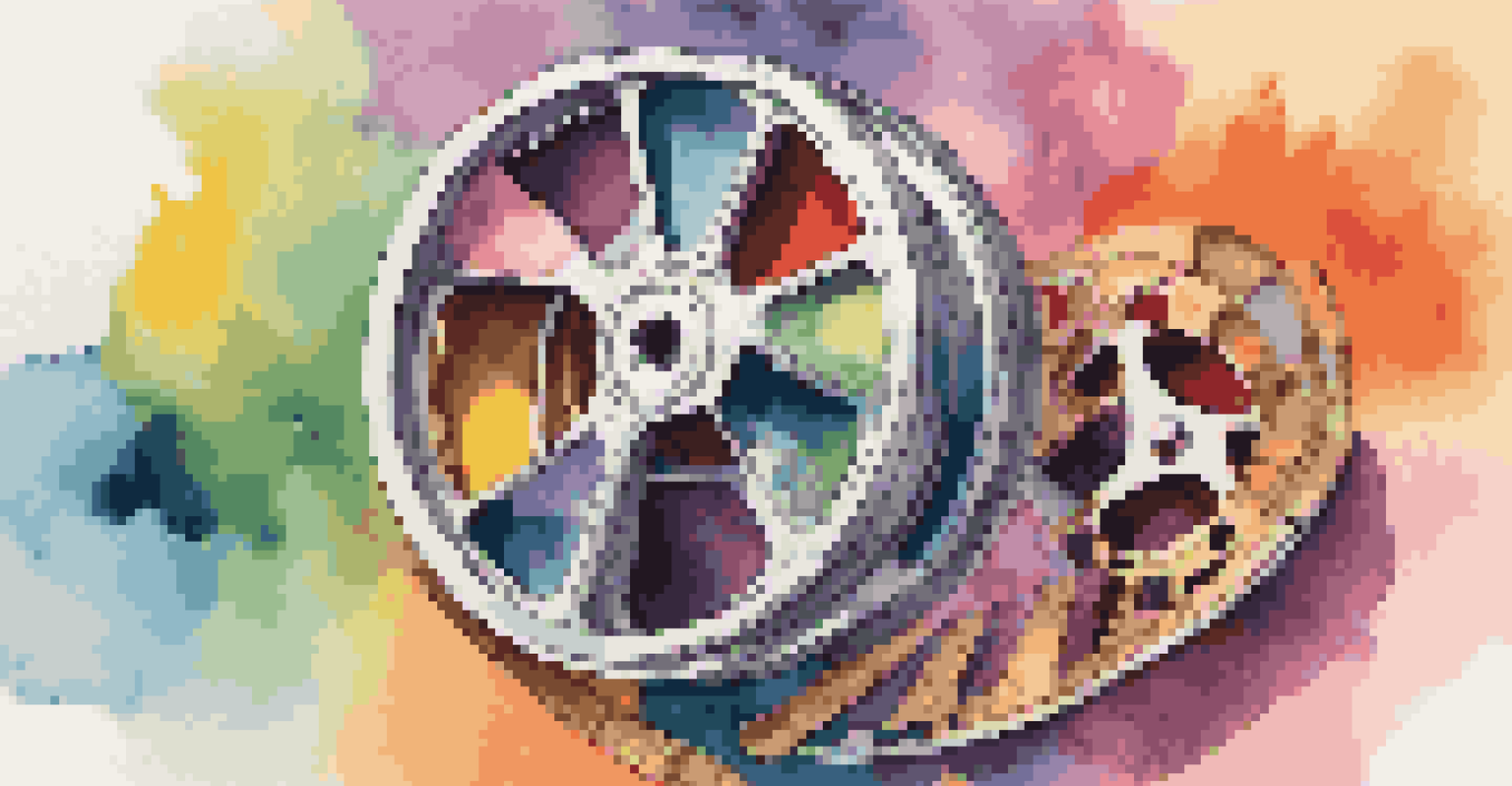Cinematic Arts: Representation of Gender and Identity

The Role of Cinema in Shaping Gender Perceptions
Cinema has long been a powerful medium that influences societal norms, especially regarding gender. Through the portrayal of characters and narratives, films shape our perceptions of what it means to be masculine or feminine. For instance, classic films often depicted women in submissive roles, while men were portrayed as dominant leaders. However, as society evolves, so too does the representation of gender in film, reflecting the growing recognition of diverse identities.
Cinema is a mirror by which we often see ourselves, and it can either reflect our true selves or impose a false identity.
Today, films are beginning to challenge traditional gender roles, presenting characters that defy stereotypes. Take the example of films like 'Wonder Woman' and 'Moonlight,' which explore complex identities and relationships. These narratives not only entertain but also provoke conversations about gender expectations and identity, pushing audiences to reflect on their own beliefs. This shift is crucial in creating a more inclusive society that values all forms of identity.
As filmmakers continue to experiment with gender representation, the impact on audiences deepens. They are not just passive consumers; they are active participants in discussions about gender identity. This evolution in cinematic storytelling encourages viewers to embrace a broader spectrum of gender expressions, ultimately contributing to a more nuanced understanding of what gender means in our modern world.
Identity Exploration: More Than Just Gender
While gender representation is crucial, identity in cinema encompasses a broader range of factors, including race, sexuality, and cultural background. Films like 'Black Panther' and 'The Farewell' highlight how these intersections create rich, multifaceted characters. By showcasing diverse narratives, filmmakers challenge the one-dimensional portrayals that have dominated mainstream cinema for decades.

These films not only entertain but serve as cultural artifacts, reflecting the realities and struggles of underrepresented communities. For example, 'The Half of It' offers a fresh perspective on LGBTQ+ relationships within the context of a coming-of-age story. Such narratives resonate with audiences who seek representation that mirrors their own experiences, fostering a sense of belonging and validation.
Cinema Shapes Gender Perceptions
Films have the power to influence and challenge traditional views on gender roles, reflecting evolving societal norms.
As audiences increasingly demand authenticity in storytelling, filmmakers are responding by crafting stories that resonate on multiple levels. The exploration of identity in cinema invites viewers to engage with complex characters and scenarios, encouraging empathy and understanding. This shift not only enriches the cinematic landscape but also promotes a culture that values diverse identities.
The Impact of Streaming Services on Representation
The rise of streaming services has revolutionized how we consume content, bringing a wider array of stories to the forefront. Platforms like Netflix and Hulu have become champions of diverse narratives, often prioritizing stories that mainstream cinema previously overlooked. This accessibility allows for more experimental storytelling that can explore gender and identity in innovative ways.
The stories we tell are a reflection of who we are and who we hope to become.
For instance, series like 'Pose' celebrate the LGBTQ+ ballroom culture, shedding light on the lives of marginalized individuals. By showcasing these unique narratives, streaming services provide a platform for voices that have historically been silenced. This democratization of content contributes to a richer, more diverse media landscape that better reflects our society's complexity.
However, with this increased representation comes a responsibility for creators to portray these stories authentically. As audiences become more discerning, there is a growing expectation for nuanced and respectful representations of identity. Streaming platforms must continue to champion diverse stories while ensuring they are told with care and integrity, fostering a culture of inclusivity in the process.
Cinematic Techniques: Enhancing Gender and Identity Themes
Beyond storytelling, the techniques employed in filmmaking also play a crucial role in conveying themes of gender and identity. Cinematography, editing, and sound design can all enhance the viewer's understanding of a character's journey. For example, the use of close-ups can create intimacy, allowing audiences to connect with a character's emotional struggles related to their identity.
Additionally, the choice of color palettes and visual motifs can symbolize different aspects of gender and identity. In 'Lady Bird,' warm tones evoke a sense of nostalgia while highlighting the protagonist's journey to self-discovery. Such artistic choices deepen the narrative, allowing viewers to engage with the themes on a more profound level.
Diverse Identities in Storytelling
Authentic representation of various identities, including race and sexuality, enriches narratives and fosters inclusivity.
As filmmakers become more adept at using techniques to convey complex themes, audiences benefit from richer cinematic experiences. This synergy between storytelling and technique invites viewers to explore their own perceptions of gender and identity, making the film-watching experience both enlightening and entertaining.
Challenges in Achieving Authentic Representation
Despite the progress made in cinematic representation, challenges remain in achieving authentic portrayals of gender and identity. Many films still fall into the trap of tokenism, where characters from diverse backgrounds are included but lack depth and agency. This superficial inclusion can be damaging, as it perpetuates stereotypes rather than challenging them.
Moreover, the production landscape can hinder authentic storytelling. Often, decision-makers in Hollywood do not reflect the diversity of the stories being told, leading to narratives that lack authenticity. For instance, when a film about a specific culture is produced by individuals outside that culture, it risks misrepresentation and misunderstanding.
To counter these challenges, it's essential for the industry to prioritize diverse voices in the creation process. By involving individuals from varied backgrounds in writing, directing, and producing, cinema can move toward more authentic representations of gender and identity. This shift not only enriches storytelling but also fosters a more inclusive industry that values all voices.
Audience Reception: The Power of Representation
The way audiences receive films that explore gender and identity can significantly impact societal perceptions. When viewers see authentic representations of characters like themselves, it fosters a sense of validation and belonging. This connection is particularly powerful for marginalized groups, who may have long been underrepresented in mainstream media.
Moreover, films that challenge traditional narratives can spark conversations among audiences, leading to increased awareness and understanding. For example, 'Call Me by Your Name' opened up discussions about sexuality and love, allowing audiences to reflect on their own experiences and biases. This engagement is crucial in promoting empathy and acceptance in society.
Streaming Services Enhance Diversity
The rise of streaming platforms has expanded the availability of diverse narratives, encouraging authentic storytelling.
As audiences demand more diverse narratives, filmmakers are encouraged to push boundaries and explore complex themes. This reciprocal relationship between audience reception and cinematic representation can lead to a richer cultural dialogue, ultimately shaping the future of storytelling in significant ways.
The Future of Gender and Identity in Cinema
Looking ahead, the future of gender and identity representation in cinema appears promising yet challenging. With the increasing awareness of diverse identities, filmmakers have a unique opportunity to craft stories that resonate with a broader audience. This shift could lead to a more inclusive cinematic landscape where all identities are acknowledged and celebrated.
However, as the industry evolves, it must remain vigilant against complacency. The push for representation cannot be a mere trend; it must become a foundational principle of storytelling. Continued advocacy for diverse voices and authentic narratives is essential to ensure that cinema reflects the richness of human experience.

As audiences continue to seek out diverse stories, the demand for authentic representation will only grow. The cinematic arts have the potential to be a powerful vehicle for change, shaping perceptions and fostering understanding. By embracing this challenge, filmmakers can contribute to a more inclusive and empathetic world, one story at a time.